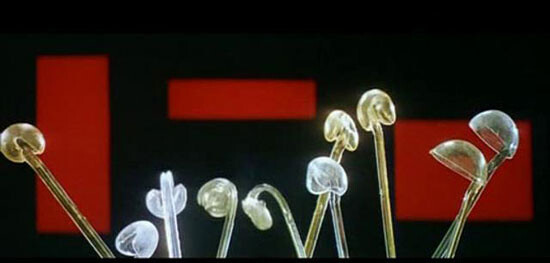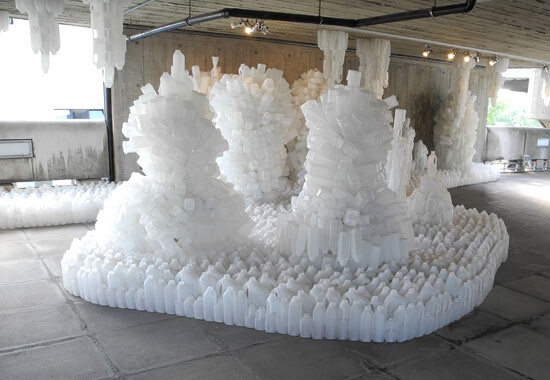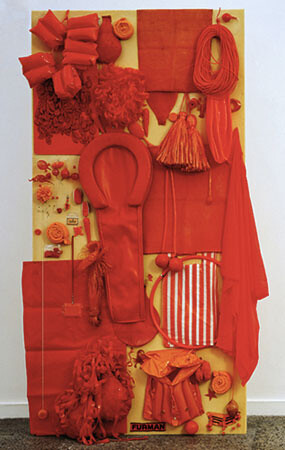Plastic is the very idea of its infinite transformation … it is ubiquity made visible … it is less a thing than the trace of a movement.
—Roland Barthes
Plastic weaves itself into every facet of our contemporary reality. It does not simply surround us, it is an epistemology and the reflection of a galling political impasse. It appears elemental; we rely on it for our built environments and for all the objects we fill them with—our toys and tools, all our gifts and trash. It orients our thoughts, mediates our senses, and shapes social and economic exchange. Indeed, plastic is less a substance than its antithesis, a paradigm in which substance is transformed into a way of being unmoored from the coordinates that stabilize presence and meaning.
Consider the recent preoccupation in contemporary art with installations that amass and redistribute plastic objects. We might think of Gayle Chong Kwan’s Wastescape (2012) at the Hayward Gallery in London, made from thousands of plastic bottles taken from a wastewater facility in Medellín, Colombia; or Vivan Sundaram’s Flotage at the 48 Degrees Celsius exhibition in Delhi in 2008. Seoul-based artist Choi Jeong Hwa experiments with the affective qualities of plastic in his stunning constructions such as Happy Happy (2010), In the Mood for Love (2010), and Kabbala (2013). Or we might think of those artists who consider the cultural signification of commodities through their accumulation and classification, such as New York–based Portia Munson in her Pink Project and Green Pieces.
These works relocate the properties of effervescence and postmodern hyperreality alongside an awareness of environmental costs and planetary limitations. More than reveling in the afterlife of worthless commodities, they disclose a less obvious dimension of the global economy—namely, its integration of the oil industry and its consequent patterning in accordance with the logic and possibility of that substance. Thus, the emergence of a plastic aesthetic is deeply suggestive of both the apprehension and excitability that surrounds global oil.
Although the rise of oil as a primary source of energy began in the nineteenth century, its centrality did not become evident to many until recent decades, when its peak and scarcity became a visible motivator and determinant of world events, such as the two OPEC-engineered oil crises of the 1970s as well as the Gulf and Iraq Wars. The Deepwater Horizon oil spill of 2010 underscored what these wars had already made clear: oil has become excessively visible, publically present, and politically charged precisely at the time of its shortage.
If plastic appears irreducible—appears to be a constitutive basis, instead of having emerged from and subsequently effaced its earthly basis—then the challenge is to uncover what plastic so readily disguises. Plastic is a petroleum product that claims at least a quarter of all the oil extracted. More than this, though, it is through plastics that we begin to fathom the complete permeation of oil into every facet of cultural life. Plastic—its pleasurable superficiality, its flexibility, its “lightness”—visualizes a time freed from restrictions and limits even as it dovetails with contemporary neoliberal fantasies about the capacity of individuals to endlessly make and re-make themselves. What is the link, then, between the economy of oil and a way of being that these artworks divulge? Between plastics and plasticity? Between objects and objectivity?
In what follows we want to return plastic to its roots in oil, and in turn to see how oil relies on the illusions and aesthetics of plastic to ensure, but efface, its universality. This procedure is not simply a matter of using the dirty truth about oil to unveil the illusions surrounding plastic: rather, it is one of thinking them as two ontological aspects of the same present. We want to re-inject oil into the bad eternity of plastic, but also think through the ways in which plastic’s “emptiness” can undercut the claims to objectivity and command of oil itself.


Akintude Akinleye, Untitled, 2012. Photo: Reuters. Worker from an illegal organization stealing oil from Nigerian pipelines to sell in the blackmarket.
Arche, Money, Time: The Ontological Echoes of Oil
In his 1957 essay “Plastic,” Roland Barthes connects the history of plastic to the rise of bourgeois capitalism, and specifically to the bourgeoisie’s espousal of imitation materials used to cheaply reproduce rare substances, such as diamonds, feathers, fur, and silk. For Barthes, however, while plastic was born of the pretension to disguise a cheap imitation as a valuable substance, it is not reviled for this fungible quality; on the contrary, plastic is celebrated precisely because of its infinite transposability. Its artifice is the spectacle. It abolishes the hierarchy of substances because it can replace them all.
There is an eternity in plastic, though one very far from the dreams of Platonism or Christianity. This is not the transcendent suspension of change dreamed of by Plato, a dream of Truth, Beauty, and of the continuing power of the Idea to engross and challenge a human body. Instead, this eternity is a persistent “reality” that arrives from one continuous, infinite, and seemingly inexhaustible source, a source without location or specificity. Plastic is always a “some” or an “any,” never a “this” or a “that.” It feels infinite because it sheds every trace of particularity, every index of a located space and time. Plastic holds form without an internal structure or skeleton, without beams, bolts, or seams, and completely negates the distance between idea and thing, mold and object. Simultaneously eternal and eminently disposable, perfect yet utter rubbish, plastic is what happens to “Ideas” under the conditions of capitalism in the postmodern age.


If we trace plastic back to its foundation in oil, we can pierce this fictional eternity that encloses us. Oil is an arche in the sense consolidated by the earliest Milesian philosophers and extended throughout the whole of the classical period. The concept of an arche in ancient Greek signals the idea of an origin or beginning, a “first cause,” but also significantly that which underlies change and renders it possible. To posit oil as an arche is not to suppose an abstruse cosmogony, but rather to tie the domain of appearance to its occluded first principle. Oil is that which generates, extends into, and proliferates as the multitude of plastic beings. It is this limitless breadth of possibilities, one that probably has no rival in nature, that makes oil an oddly feral god, one that mirrors the infinite “well” of creativity from which thought itself draws. Oil’s “naturalness” allows us to imagine it alongside earth, water, wind, and fire as an essential element. Yet it is synthetic, extracted and refined only through exhaustive industrial processes that locate it within the jurisdiction of a paradigmatic artificiality.
There is almost no aspect of postwar growth culture, from its reliance on the automobile to the commoditization of plastic, which has not been conditioned by oil: what remains to be thought is how the universalization of oil—and therefore a revival of a discourse of singularity (“oneness”)—establishes the conditions for capital’s spectacular plenum, populated by interminable strata of particular pleasures and objects. A “society of the spectacle” that originates from oil rehearses the platonic agonism between appearance and reality. Yet, by its very own rule of homogeneity, oil combines false appearance and terrestrial reality. It is an essence without transcendence or illumination. It is not a substance in the Spinozan sense of something conceived in and through itself; nor is it something eternal or immutable like Spinoza’s infinite modes. Instead, oil is a way: in its becoming ontological, oil has become causal. It is ontological and it ontologizes.
No substance, however, can be deemed ontological if it does not first pass through an essential mediation by money. Air, for example, is structurally indispensable to all of nature, to biological life in its entirety. But air is not the substance par excellence of capitalist modernity. If money, within the domain of capitalist sociality, is as close a thing to an efficient cause as we have—a direct impetus to the motion of bodies both human and inhuman, moving containers off of ships, moving workers into factories—then oil is the lifeblood of this mechanism. Oil is the vital material coursing through the symbolic channels of economic transactions. It is not that any of this would continue to work without labor or dreams or language, without social imaginaries or micropolitical systems: it is only that amidst this genuine complexity there remains a bald linearity, a reliance on a classically Cartesian mode of mechanist causation. For a society that envisions itself as infinitely complex, as filled to the brim with particularity and individuality, oil does in the sphere of physical bodies what money does in the sphere of desire.
Oil subtends the present only because it is also a uniquely sensitive region in the broader body of capital itself. Not only do oil companies occupy the commanding heights of contemporary economies, controlling empires of material, land, and labor; oil is also a preferred currency in itself, an unquestioned store of monetary value. Its financialization allows oil to function as a speculative instrument bought to transform money into more money. It is this link between oil and money that exerts an almost alchemical power over the fabric of the capitalist life-world. When we add to this link economist Jeff Rubin’s thesis that there is a self-cancelling relationship between economic growth and oil prices, whereby growth feeds demand and increased costs dampen growth, we can begin to explore a reality in which money’s universality has reached its substantive limit in oil, and the two jockey for symbolic dominance.
Finally, it matters that oil is very literally time materialized as sediment, buried deep in the ground. Oil is not just time: it is the energy made possible by eons of fossilized death. Though air and water, for example, are primeval substances, they are not recognizably historical. Certainly they have complex histories, but never are they bound to a determinate geological strata, to a specific or irreversible moment in the history of the planet. Air and water appear to us like numbers or primary colors; we imagine them forever reproducing their own essentiality. Oil, however, happens only once. It is wrenched from the deep and driven into visibility: an arrow fired through history. We are therefore witnesses to this fabricated essence called oil, this causa efficiens composed of time and death.


Objectivity and the Visibility of Oil
It is here that plastics reenter the discussion, for they make visible a stratigraphy of oil capital. Why is this stratigraphy relevant, when oil itself is in no way concealed from view? Inasmuch as the problem of oil lies in its ubiquity and apparent inescapability as a source of energy, profit, and cultural life, the ways we see it seem incontrovertible. The challenge, then, is to leverage a view of oil that does not succumb to its hold on objectivity.
Most often when we think about oil, we do so in one of two ways: either as a prized resource, “black gold”; or as an industry with a specific location that operates within a predictable set of political variables that tend to revolve around issues of environmental negligence and corporate corruption. This division between priceless energy source and toxic apparatus has led to a battle of objectivities in the visual field. On the one hand, the seemingly unstoppable momentum of oil sands technology and pipeline expansion has been bolstered by a series of corporate and governmental campaigns that repitch oil as productive, prosperous, and even energy efficient. This rationale based on a rhetoric of technological and scientific advancement is strengthened by the claim that the oil industry generates employment. On the other hand, no one can ignore the deluge of media images of pipeline malfunctions, spills, tailing ponds, and monumental “landscrapes” amid headlines about cancer, toxic groundwater, and the ongoing problem of carbon emissions.
Dirty oil has found its way into the world of art and film too, particularly in the documentary genre. Take, for example, the photographer Edward Burtynsky’s series Oil, which maps the trajectory of the industry from early extraction technologies to the development of the tar sands, from the refinement of oil to car culture and the afterlife of oil manufacture. Ursula Biemann’s 2005 video The Black Sea Files tracks the construction of a new subterranean pipeline that crosses The Caucasus to pump oil to Western Europe. The video shows the pipeline being built, but Biemann punctuates this endeavor with a human geography of interviews that she conducts with workers, farmers, prostitutes, and refugees whose lives are governed by the pipeline. The video, she claims, “displaces the singular and powerful signifying practices of oil corporations and oil politicians.” In a similar vein, Allan Sekula’s photographic series Black Tide (2008) combines a human geography with scenes of environmental disaster as it documents the cleanup of the Galician coast after a massive oil spill caused by the sinking of the oil tanker The Prestige.
If oil has a hold on objectivity, it is through the saturation of the visual field. Oil is hypervisible precisely at the moment when the industry is attempting to overcome its peak and scarcity through extreme technological measures. Attempts to unconceal it, in the Heideggerian sense, are foreclosed by the sheer saturation of information, emotion, and opinion that distorts and contorts the ground of rational criticism.
The recent modus operandi of contemporary artists to accumulate and redistribute plastic objects shows us the depth of the problem of oil through different terms of visibility. Oil is not simply a political terrain limited to land claims, environmental management, and economy. It is a cultural and aesthetic mesh that mediates the sensorial field. The general tenor of these works shifts the visual field away from the efforts to objectively expose the dirty truth of the oil industry, to works characterized by a sensorial fullness, robustness, and flexibility. A clear example of this shift from industrial exhaustion to plastic exuberance can be found in the work of Melanie Smith, a Mexico City–based artist. Since the early nineties, Smith’s work has addressed what has been called an everyday phenomenology of capitalism in Mexico. One of her better-known works is Spiral City, a homage to Robert Smithson’s Spiral Jetty that takes the sprawl of Mexico City as its subject. Where Smithson’s film culminated in a sequence of spiraling aerial shots taken from a helicopter of his monumental sculpture in the Great Salt Lake in Utah, Melanie Smith’s Spiral City revolves around Mexico City, the helicopter countering the order of the urban grid by moving in ever-widening circles. The effect is a visualization of the city as entropic sedimentation: it is decentered, disoriented, sprawling, repetitive, voided of life and color.
Smith exhibits the video, however, with a series of installations that seemingly stand in contrast. Orange Lush, for example, is comprised of bright orange plastic objects, among them life-preservers, extension cords, buoys, cheerleader pom-poms, water wings, flip-flops, light bulbs, balloons, and water rafts. For all their ordinariness, however, the layout of the objects is not arbitrary: the subtle distinction between full, rounded objects and deflated, pendulous ones thematizes a broader stalemate between sensorial plenitude and economic exhaustion.
Smith chose orange in particular because it was the color that marked the invasion of Mexico City by cheap commodities in the 1990s, after inflation and bailouts from the US and the Bank for International Settlements caused a devaluation of the peso. At the conjunction of Mexico’s preindustrial economy and global capitalism, orange was the color of superadded value and fake excitement about otherwise worthless merchandise, or what the artist calls “chemically-induced enthusiasm.” In this way, she visualizes the economy as an aesthetic sensibility, not just to picture an industry like oil or plastics, but to link the dissemination of plastics to jubilant accumulation, as a worthless double of profit that is gathered together as wealth. Orange plastic is not just an objectification of global petroculture; it is also its mood and mode.


A Plastic Thought In the Time of Oil
If plastic has effaced its earthly source, we might be hard-pressed to make the connection between plastics and global oil: whereas plastic persists, accumulates, is valueless, infinitely transposable, and therefore seemingly voided of ontological stability, oil is scarce, undoubtedly earthen (extracted only by extreme measures), it is desired, consumed, and promises plenitude and wealth. Yet both are part of a coextensive economic and aesthetic regime. Looking at oil is not a material corrective to the superficiality of plastic—far from it. Oil generates a plastic operation. Every aspect of the oil industry relies on techniques of transposability that we can associate with plastics as circulating commodities and with plasticity as a myth of eternal and limitless transformation. This industry turns sand into fuel, repitches trash as art, reformulates the scarcity of oil into the accumulation of profit, spins environmental disaster into job opportunities, contorts environmental science into mere “politics,” and fabricates the moods with which we should perceive and interpret our energy sources. In the plastic predicament, when the senses are saturated and affects prescribed, the question remains: What kind of critical gesture can be made in the face of plastic’s inexhaustible exchangeability?
